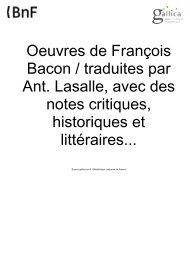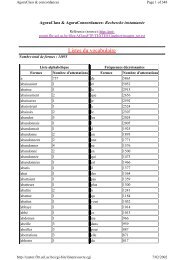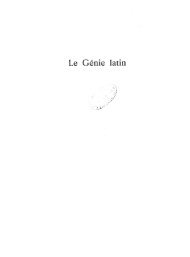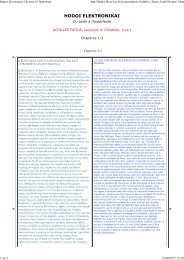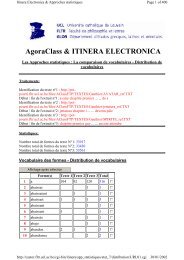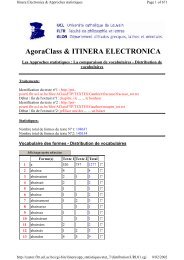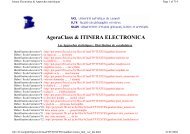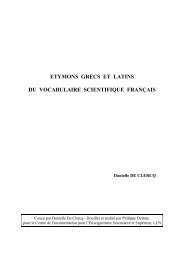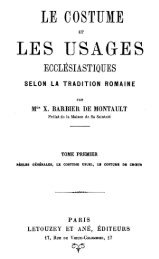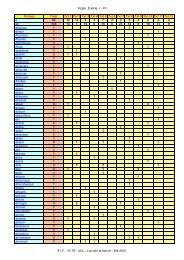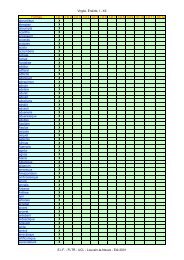The Etymologies of Isidore of Seville - Pot-pourri
The Etymologies of Isidore of Seville - Pot-pourri
The Etymologies of Isidore of Seville - Pot-pourri
Create successful ePaper yourself
Turn your PDF publications into a flip-book with our unique Google optimized e-Paper software.
extant, treating specific disciplines: grammar, rhetoric,<br />
medicine, law, geography, architecture, philosophy,<br />
chronology, logic, music, ecclesiastical and theological<br />
matters, and the rest. Outstanding among these are the<br />
treatises <strong>of</strong> Boethius (480–524), covering the disciplines<br />
<strong>of</strong> the quadrivium as well as important translations and<br />
commentaries on logic; the standard grammatical works<br />
<strong>of</strong> Donatus (fourth century), Sacerdos (third century),<br />
and Terentianus (late second century); the many legal<br />
compilations <strong>of</strong> Julius Paulus (ca. 210) and Ulpian (died<br />
223), whose works were used in the great codifications<br />
under Justinian (529–534); Vitruvius’s (late first century<br />
bce) On Architecture;foragriculture the works <strong>of</strong> Palladius<br />
(fourth century), partly based on Columella (60–<br />
65 ce); Marius Victorinus’s (fourth century) translations<br />
<strong>of</strong> Greek philosophical texts; the geographically<br />
arranged miscellany <strong>of</strong> lore, practically an encyclopedia,<br />
the Collection <strong>of</strong> Memorable Things (soon after 200)<strong>of</strong>G.<br />
Julius Solinus; and for history and chronology Jerome’s<br />
31 On historiography before and after <strong>Isidore</strong> see R. McKitterick,<br />
History and Memory in the Carolingian World (Cambridge, 2004).<br />
32 On this see especially Fontaine (1966).<br />
33 On such “transmitters” <strong>of</strong> classical culture as Boethius, Cassiodorus,<br />
and <strong>Isidore</strong> see E. K. Rand, Founders <strong>of</strong> the Middle Ages<br />
(Cambridge, MA, 1928). Broadly for the period see M. L. W. Laistner,<br />
Thought and Letters in Western Europe, AD 500–900 (Ithaca,<br />
NY, 1931), and esp. Riché (1976) and J. J. Contreni, “<strong>The</strong> Carolingian<br />
Renaissance: Education and Literary Culture,” in R. McKitterick,<br />
ed., <strong>The</strong> New Cambridge Medieval History, vol. ii c. 700–c. 900<br />
(Cambridge, 1995: 709–57).<br />
34 <strong>The</strong> openings <strong>of</strong> three other books, X, XIII, and XIX, refer<br />
without specification to <strong>Isidore</strong>’s abbreviation <strong>of</strong> his sources. Three<br />
chapter titles refer to sources (II.xxv, xxvi, and xxix).<br />
35 Díaz y Díaz observes that <strong>Isidore</strong> uses similar phrasing when<br />
speaking <strong>of</strong> his intentions in the preface to his treatise On the Nature<br />
<strong>of</strong> Things: “presenting some statements about the nature and causes<br />
<strong>of</strong> things ...all<strong>of</strong>whichIhavenotedinabriefsketch(brevis tabella)<br />
according to what has been written by the ancients and especially<br />
in the works <strong>of</strong> Catholic writers” (Oroz Reta and Marcos Casquero<br />
1993 2 :176).<br />
36 <strong>The</strong> information about those whom <strong>Isidore</strong> names, and those<br />
whom he directly quotes (whether or not naming the specific source),<br />
may be gleaned from two indexes in the Reta–Casquero edition<br />
(1993 2 ): “Index nominum” and “Loci citati in textu.” <strong>The</strong>se do not<br />
include <strong>Isidore</strong>’s quotation or paraphrase <strong>of</strong> sources where he gives<br />
no indication <strong>of</strong> doing so. In what follows we collect statistics from<br />
these indexes with the caveat that they contain many errors.<br />
37 <strong>Isidore</strong> appears to quote Varro at I.iii.1, I.xxvii.15, I.xxxviii.1,<br />
II.xxiii.1, IV.viii.13, IV.xi.5, VIII.vi.21, VIII.vii.3, IX.ii.74,X.185, XI.i.51,<br />
XI.i.97, XIII.i.2, XIII.xviii.2, XV.xiii.6, XVII.ix.95, XX.x.1, XX.xi.9 and<br />
otherwise names him as his authority at VIII.ix.13, XI.iii.1, XIV.vi.18,<br />
XIV.vi.36, XIV.viii.33, XIV.ix.2, XV.i.63, XVII.vii.57, XVII.i.1, and<br />
XVIII.xvi.2.<br />
<strong>The</strong> sources <strong>of</strong> the <strong>Etymologies</strong> 13<br />
translation and continuation to the year 378 <strong>of</strong> Eusebius’s<br />
Chronicle, Rufinus’s translation and continuation (late<br />
fourth century) <strong>of</strong> Eusebius’s Ecclesiastical History (early<br />
fourth century), and Paulus Orosius’s History Against the<br />
Pagans (418). 31<br />
From this survey it appears that <strong>Isidore</strong>’s twin informing<br />
principles, etymologizing and encyclopedism, descend<br />
from ancient and distinguished ancestry. 32 In that the<br />
<strong>Etymologies</strong> amounts to a reorganized redaction and<br />
compendium <strong>of</strong> writings mainly <strong>of</strong> the fourth to sixth<br />
centuries (with the large exception <strong>of</strong> Pliny), it could<br />
be said that his work is not merely conditioned by,<br />
but in the main is comprised <strong>of</strong>, the major components<br />
<strong>of</strong> intellectual history as they were handed down<br />
to him. He had access, albeit largely indirect, to the<br />
major traditions <strong>of</strong> Latin learning reaching back 800<br />
years, from Gregory the Great to Cato. Like his fellow<br />
“transmitters” 33 from Servius to Cassiodorus, <strong>Isidore</strong><br />
quite consciously preserved, in abbreviated form, the<br />
accumulated learning <strong>of</strong> the classical world. As his disciple<br />
Braulio remarked in his Renotatio,“Ourown time<br />
indeed found in him a likeness <strong>of</strong> the knowledge <strong>of</strong><br />
antiquity, and in him antiquity reclaimed something for<br />
itself...Godencouragedhim...topreservetheancient<br />
monuments . . .”<br />
Apart from the dedication to Sisebut <strong>Isidore</strong> does not<br />
speak generally about his use <strong>of</strong> sources in the <strong>Etymologies</strong>,<br />
with one exception, his use – particularly his occasional<br />
augmenting – <strong>of</strong> Jerome’s work explicating the<br />
meaning <strong>of</strong> Hebrew terms (VII.i.1). 34 More vaguely, he<br />
claims to avoid presenting material about the founding<br />
<strong>of</strong> cities when the authorities differ among themselves,<br />
giving examples <strong>of</strong> such dissension from Sallust and two<br />
places in the Aeneid (XV.i.1). At the beginning <strong>of</strong> Book<br />
XIII he emphasizes that he will tell <strong>of</strong> the cosmos in a<br />
“brief sketch” (brevis tabella) and “with compendious<br />
brevity” (conpendiosa brevitas), implying abbreviation<br />
<strong>of</strong> his sources. 35<br />
Because <strong>Isidore</strong> derives his information mainly at second<br />
or third hand, his actual naming and even quoting<br />
<strong>of</strong> earlier scholars is no reliable guide to his immediate<br />
sources. Let the crucial figure <strong>of</strong> Varro, at the head <strong>of</strong> the<br />
encyclopedic tradition in which the <strong>Etymologies</strong> stands,<br />
serve as an example. 36 <strong>Isidore</strong> names him as his authority<br />
for various facts twenty-eight times, and appears<br />
to quote him eighteen times. 37 <strong>The</strong> first ten <strong>of</strong> these



